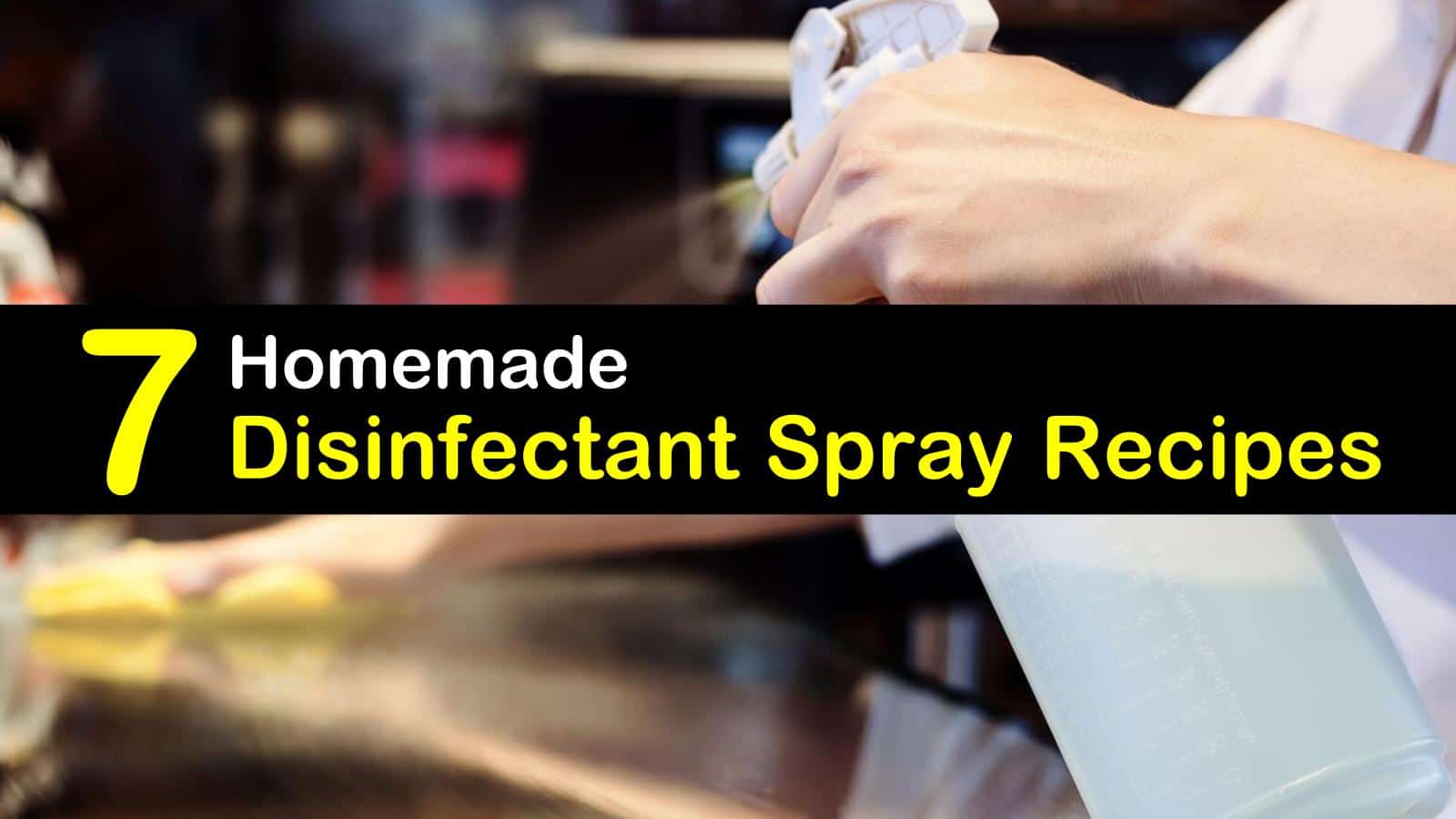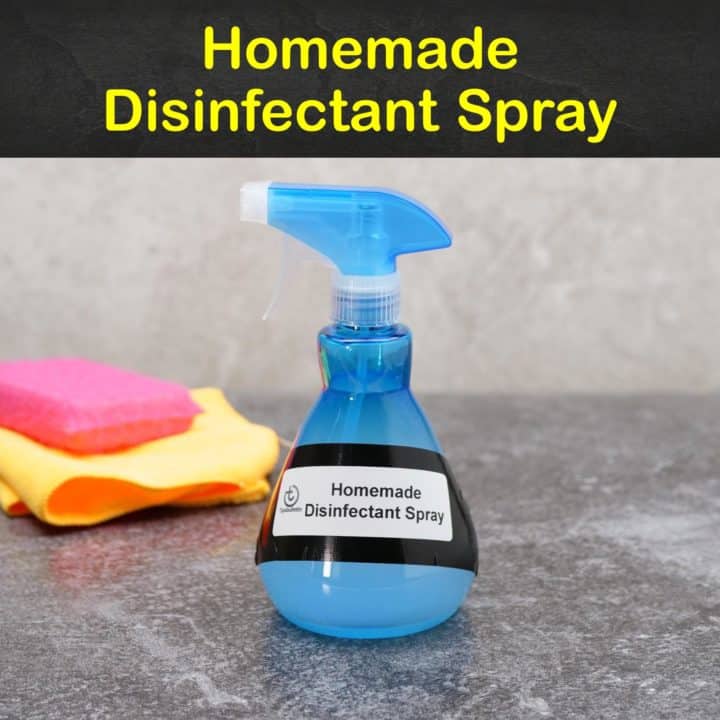If you want your home to sparkle, then finding an effective disinfectant is essential. Unfortunately, many store-bought cleaning products contain harsh chemicals that you may not want to bring into your home. Using natural ingredients, you can make a homemade disinfectant spray that is not only cheap but is free of toxic chemicals.
Thankfully, there are antibacterial, natural ingredients that can protect your home and personal items from collecting harmful microbes. Making your own homemade natural cleaners is not only better for the environment, but it gives you more control over the results.
It’s easy to adjust these disinfecting spray recipes to suit your cleaning routine to ensure your walls, floors, door knobs, and other belongings get cleaned well. Knowing what ingredients work best on which surfaces, helps you determine the best homemade disinfectant spray recipes for specific uses in your home.

Homemade Disinfectant Spray and DIY Hand Sanitizer Recipe for Coronavirus COVID-19
With a global coronavirus pandemic now in place, it is vital to ensure personal safety against the spread of COVID-19. We must protect ourselves and keep others from becoming contaminated as well.
There is a significant difference between cleaning a surface and disinfecting it . Cleaning removes germs and decreases the likelihood of infection. Disinfecting kills germs via chemical means after a surface has been cleaned. Completing both steps is necessary to prevent the spread of disease.
Each has specific guidelines for personal protection and sanitization purposes.
Hydrogen Peroxide
A 3% concentration of hydrogen peroxide can be used alone or diluted to 0.5% for decontaminating.

Mix the ingredients in a sprayer. Spritz hands or surfaces and let the solution sit for at least one minute before wiping away.
Alcohol
Mix alcohol and aloe vera gel to make your own hand sanitizer. The hand sanitizer must “sit on your skin” for at least 30 seconds to completely disinfect. According to the CDC (1), a mixture that includes at least 60% alcohol successfully kills coronavirus pathogens.
Alcohol Concentration:
- The CDC (2) recommends using a 70% isopropyl alcohol or 60% ethanol.
- The FDA (3) recommends using at least a 75% isopropyl alcohol to be used in hand sanitizers.
- Rutgers University (4) recommends using at least a solution of 70% alcohol.
You can also combine alcohol and water for sanitizing hard surfaces, but it can be rough on the skin and is not recommended for that purpose.
Ensure you keep any alcohol-based disinfectant in a well-sealed container, so it does not evaporate between uses.
Bleach
Wear gloves to apply the solution to countertops, doorknobs, remotes, tables, etc. Use the liquid within 24 hours, as time weakens the disinfectant. Decontaminate for at least 30 seconds, but exposure for ten minutes is best.
Household bleach is ideal for sterilizing most surfaces. Be careful as many materials will be damaged or destroyed if exposed to bleach.
Easy-to-Make Disinfectant Spray Tips & Recipes
Homemade Disinfectant Spray
This simple, natural disinfectant is a perfect multi-purpose spray that you can use on almost all surfaces and makes a great glass cleaner. Avoid using this cleaner on marble and granite, as the acid in the vinegar may leave marks.
Pour the amazing peppermint oil and all ingredients in a glass spray bottle and shake to ensure they’re combined. Spray on any surface and let it sit for about 10 minutes to allow the disinfectant properties to do their work. Wipe the spray clean using a microfiber cloth.
Natural Floor Cleaning Disinfectant
You can use this all-purpose disinfectant floor cleaner on hardwood, laminate, vinyl, linoleum, and tile floors. You may want to use sparingly on marble and granite.
Combine all ingredients in a large bowl and stir. Once mixed, pour the natural disinfectant into a plastic spray bottle. Shake well before use, and spray on any floor that requires cleaning. Wipe up the solution with a mop. Note: do not use Castile soap or any other oil-based soap.
DIY Disinfectant Spray
This disinfectant spray recipe is perfect for deep-cleaning as it contains Borax. You can find Borax, or sodium borate, at grocery or hardware stores.
Some people worry about the safety of Borax, as the FDA banned it as a food additive. While it’s not suitable for ingesting, it is safe for cleaning. This recipe also makes an effective DIY toilet cleaner.
Pour all the ingredients into a squirt bottle and shake to combine. Spray the disinfectant and let it sit for 10 minutes before wiping with a cloth. If you are using it as a toilet cleaner, let it sit for a few hours before using a toilet brush to scrub the interior and flush to rinse.
Homemade Disinfectant for Countertops
The kitchen can quickly turn into the messiest room in any house, and keeping the countertops free of germs and bacteria is vital to stay healthy and avoid getting sick.
This is one of our favorite DIY recipes because it only requires two ingredients: water and hydrogen peroxide. Mix equal parts water and hydrogen peroxide and pour into a spray bottle.
Spray on your kitchen countertops as needed, then wipe off with a sponge. You can also use this disinfectant on bathroom countertops, or any other hard surface susceptible to germs. Try it to sanitize a wood dining table, coffee table, or dresser, too.
Natural Disinfectant for Granite
If you need to disinfect granite countertops or any other granite surface, you need to be more careful about the ingredients you use. Even when you are making cleaners, some of them may cause damage to specific surfaces if you’re not paying attention.
Too much acidity leaves etchings in surfaces like marble or granite, so you should avoid ingredients like vinegar, bleach, ammonia, or lemon juice. To clean your countertops, start by removing all items and swipe up dirt and crumbs.
Combine mild dish soap with warm water, either in your sink or in a bucket. Dip a microfiber cloth into the soapy mixture and wring out the excess before wiping down the countertops. Grab a dry facecloth and wipe the countertops once more.
DIY Natural Disinfectant Spray
This natural disinfectant spray uses the antifungal and antibacterial powers of essential oils like tea tree oil to kill germs and prevent bacteria from taking over. It is perfect for yoga mats, exercise equipment, and any other surface that attracts bacteria.
Fill a spray bottle with the ingredients and tighten the lid. Shake well to ensure all elements combine. Spray on any surface that needs disinfecting and then wipe clean. Be sure to shake the solution before use, as the oil separates.
Homemade Disinfectant Wipes
Lysol disinfectant wipes are handy and convenient to have around the house, but the disposable cloths are not suitable for the environment. Additionally, the costs of these wipes can add up. Making reusable cleaning wipes is easy and affordable.
Combine all ingredients in a wide-mouth glass Mason jar or similar container. Replace lid and swirl to combine. Press pre-cut cloths or washcloths in the jar until all fabric is wet with disinfectant liquid. Replace cover and store in a dark space.
To use the disinfectant wipes, pull out a cloth when needed and squeeze out the excess liquid. Use on any glass, stainless steel, tile, linoleum, or porcelain surface. When finished, place the used cloth in the laundry.
These natural disinfecting spray recipes and cleaning tips will have your house looking cleaner than ever. The gentle, natural ingredients are perfect for worry-free cleaning without having to break the bank. With these recipes, your home will not only be free of harmful chemicals, but you’ll also be taking steps to be kinder to the environment.
Recipe for Homemade Disinfectant Spray

Homemade Disinfectant Spray
Yes, you can clean with vodka!
Materials
- 2 ounces of cheap vodka
- 2 ounces of vinegar
- 10 ounces of water
- 15 drops of lemon or peppermint essential oil
Tools
- Measuring cup
- Glass spray bottle
- Microfiber cloth
Instructions
- Add all the ingredients to a spray bottle and shake gently.
- Spritz on a surface you want to disinfect.
- Allow it to sit for at least ten minutes.
- Wipe off the cleaner with a microfiber cloth.
Notes
Essential oils degrade plastic spray bottles over time, so use a glass one.

We hope you enjoyed this article detailing the benefits of making your own homemade disinfectant sprays and cleaners. If you found these recipes helpful, then share these disinfectant tips with your friends on Facebook and Pinterest!
3 FDA.gov